Have you ever been intrigued by the unique and adorable fluff-ball birds known as Silkie chickens? These fascinating creatures have a long history and many peculiar features that set them apart from other chicken breeds.

From their ancient Asian roots to modern-day popularity as pets and backyard companions, Silkie chickens have captured the hearts of poultry enthusiasts worldwide.
In this article, we uncover the secrets of their mysterious past, their unique features, and why these fluffy, friendly creatures, the Silkie chicken, make such an excellent addition to any flock or family.
Short Summary
- Silkie chickens have a long history and are renowned for their unique features, including black skin, blue ears, five toes, and feathered legs.
- Silkies possess strong maternal instincts and lay small creamy-brown eggs of high quality. Regular preventative measures must be taken to maintain health.
- Fourteen varieties are recognized by the American Poultry Association in Bantam size. The APA does not recognize the standard breed fowl sizes
- Eighteen recognized varieties with the American Bantam Association (ABA)
- Raising them requires careful consideration for their well-being.
Silkie Chicken Origins and History
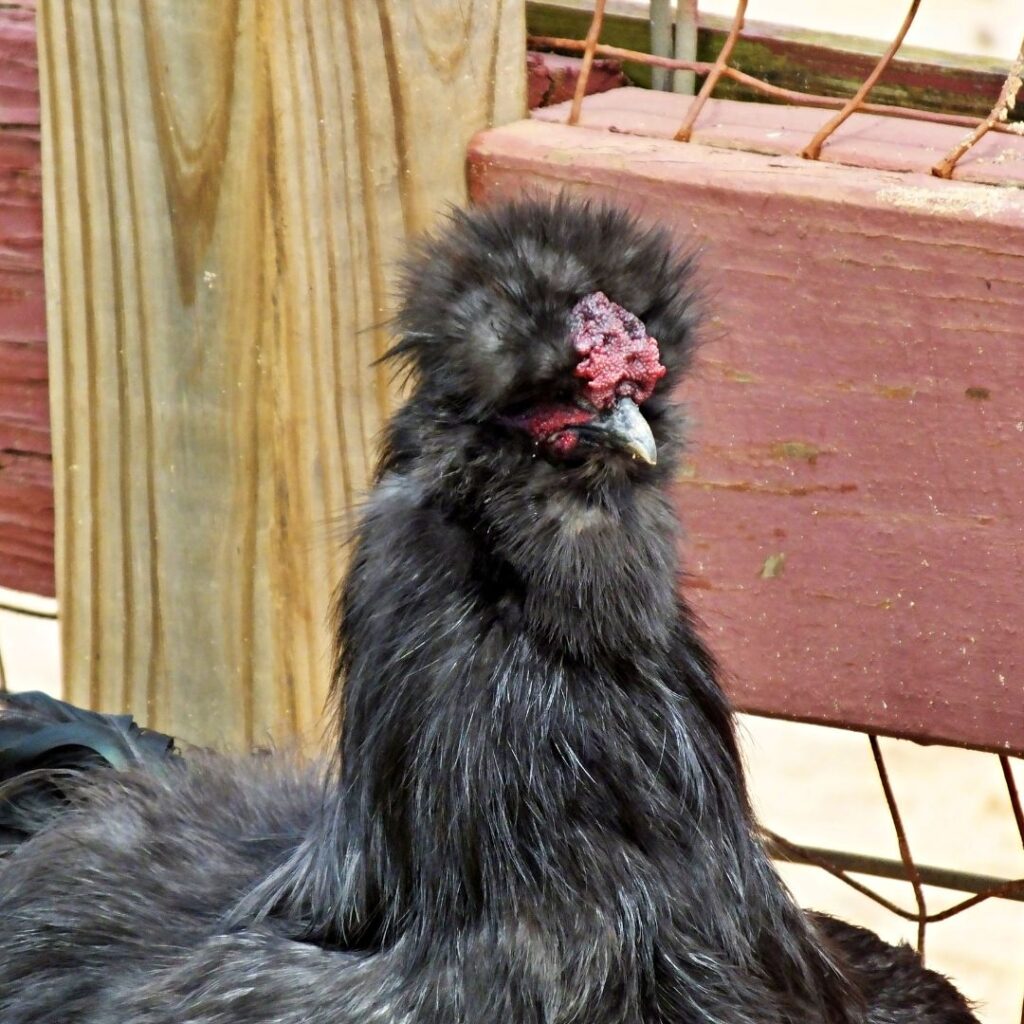
Where do silkie chickens come from? Silkie chickens are believed to have originated in China during the Han dynasty, approximately 200 BC. These fascinating birds have been supplying eggs and meat for the wealthy in China and the Far East for centuries and were initially brought to Europe in the 1800s. Marco Polo’s reference to furry chickens during his travels in Asia is the earliest surviving record of Silkie chickens. This took place during the 13th century.
Many myths and misconceptions surround the Chinese Silk chicken in the West; it was widely believed that they resulted from a chicken and rabbit mating, which led to their unique fur-like feathering. However, these myths have long been debunked, and Silkie chickens have become popular as a source of eggs and meat and as charming pets and backyard companions.
Their distinctive appearance and friendly demeanor have made them a favorite among poultry keepers and enthusiasts worldwide. Today, Silkie chickens can be found in various colors and varieties, which we will explore further in this guide.
Unique Features of Silkie Chickens
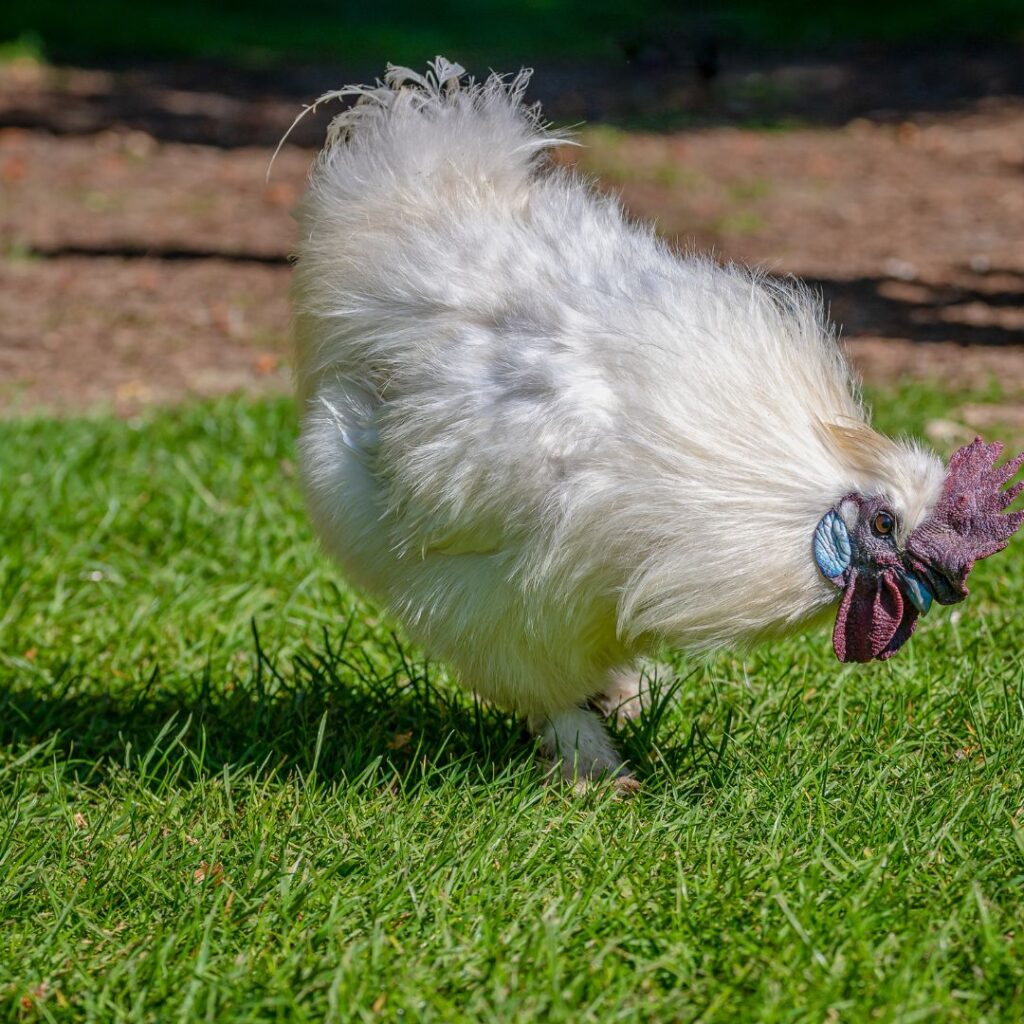
In the U.S., the Silkies are Bantams. However, there is a standard-sized Silkie breed found primarily in European countries. Sometimes referred to as large fowl, these standard sized breeds are still relatively small chickens.
- Silkie Rooster (standard) 4 lbs
- Silkie Hen (standard) 3 lbs
- Silkie Rooster (bantam) 36 oz
- Silkie Hen (bantam) 32 oz
Interesting, the Silkie Bantam is considered a ‘true’ bantam, meaning it had no larger chicken of its likeness. Many ‘miniaturized’ bantams are bred as smaller versions than the original breed, like the Rhode Island Reds and Bantam Rhode Island Reds.
What makes this bird interesting is the ‘true’ Silkie bantam came first, then the standard breed was developed after.
Silkie chickens possess unique features that set them apart from other chicken breeds. They have black skin, blue ears, five toes, feathered legs, and walnut combs. Additionally, they have crested head feathers, and some may even have beards, adding to their distinct appearance.
However, one of their most striking features is their fur-like feathering, which lacks barbicels. This unique feather structure affects not only their appearance but also their abilities.
Silkie chickens typically lay their eggs on the coop floor because their head plumage can block their vision and ability to watch for predators.
Despite these quirks, these fluffy chickens are cherished by many for their endearing and docile nature, making them excellent pets and backyard companions.
The following sections will go deeper into their unique feather structure and charming personalities.
Feather Structure
Silkie chicken feathers have fur-like fluffy plumage, lacking the barbicels in most other chicken feathers. Barbicels are the hooks that unite the barbules in most feathers, providing structure and strength. The absence of these barbicels gives Silkie feathers their fluffy appearance.
This unique feather structure has drawbacks, as it leaves Silkies incapable of flying and vulnerable to predators.
Furthermore, their fluffy feathers can become easily soiled and require regular grooming to maintain their health and appearance.
Silkies are still beloved despite these challenges for their distinctive, endearing looks.
Crested Head and Beards

The distinctive head of a Silkie chicken is characterized by a spherical puff of feathers on top of the head, similar to a pom-pom. This charming feature adds to their unmistakable appearance and differentiates them from other chicken breeds.
In addition to their crested heads, some Silkie varieties have beards composed of elongated feathers beneath the beak. These are called bearded Silkies
The comb of a Silkie chicken should resemble a walnut, almost circular, and black or dark mulberry. While these head features and feathering certainly contribute to the Silkie chicken’s unique charm, they can also impede their vision, affecting their foraging abilities and overall demeanor.
Silkie Chicken Colors and Varieties
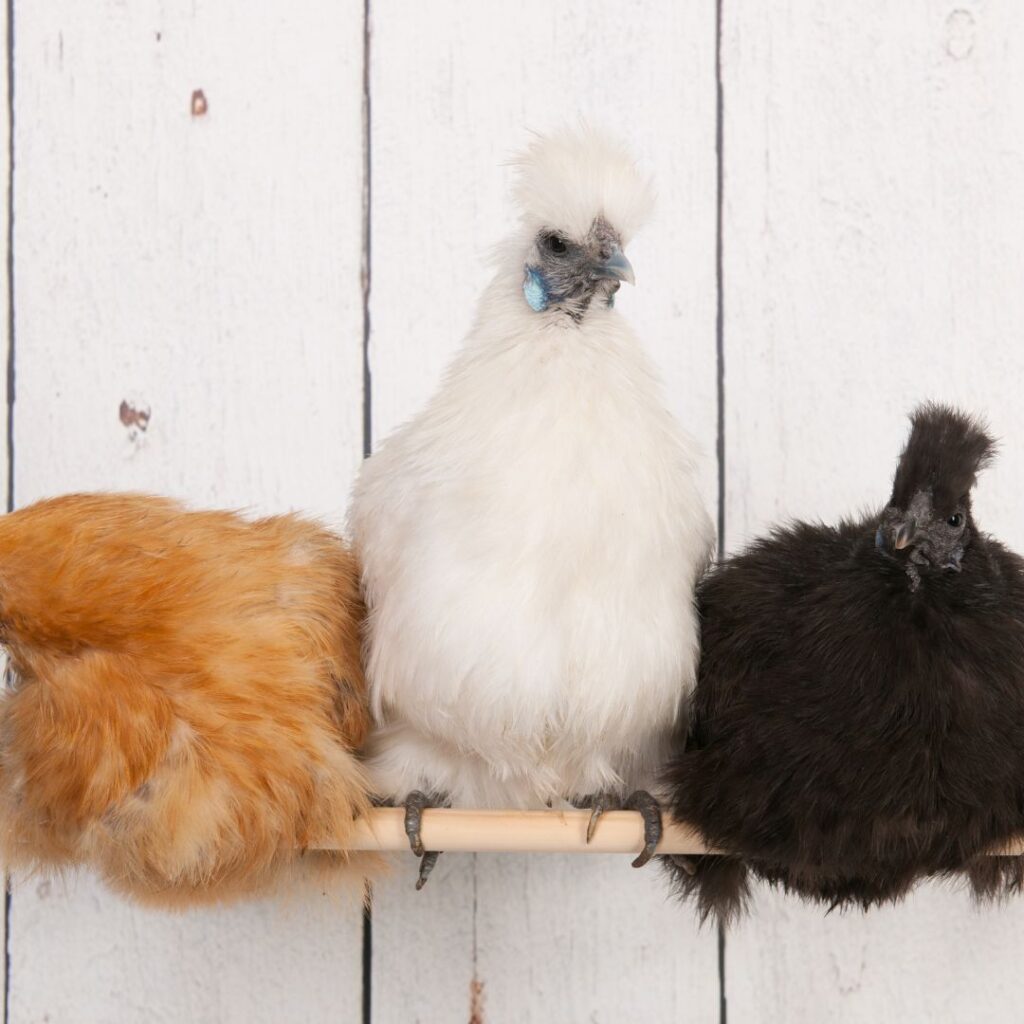
Silkie chickens come in a variety of colors, with eleven recognized by the American poultry association. These colors include buff, white, black, blue, splash, partridge, and grey. In addition to these recognized colors, breeders are developing more colors, adding to the diversity and appeal of this unique chicken breed.
The American Bantam Association recognizes 18 breed varieties.
In the United States, Silkies are only recognized as bantams, although breeders have bred them up to large fowl in certain areas.
No matter the color or size, these charming birds continue to captivate poultry enthusiasts and families with their distinctive appearance and friendly personalities.
Below is a list of the 14 Silkie Bantam varieties accepted by the APA:
- Bearded Black
- Non-Bearded Black
- Bearded Blue
- Non-Beaded Blue
- Bearded Buff
- Non-Bearded Buff
- Bearded Gray
- Non-Bearded Gray
- Bearded Partridge
- Non-Bearded Partridge
- Bearded Self Blue
- Bearded Splash
- Bearded White
- Non-Bearded White
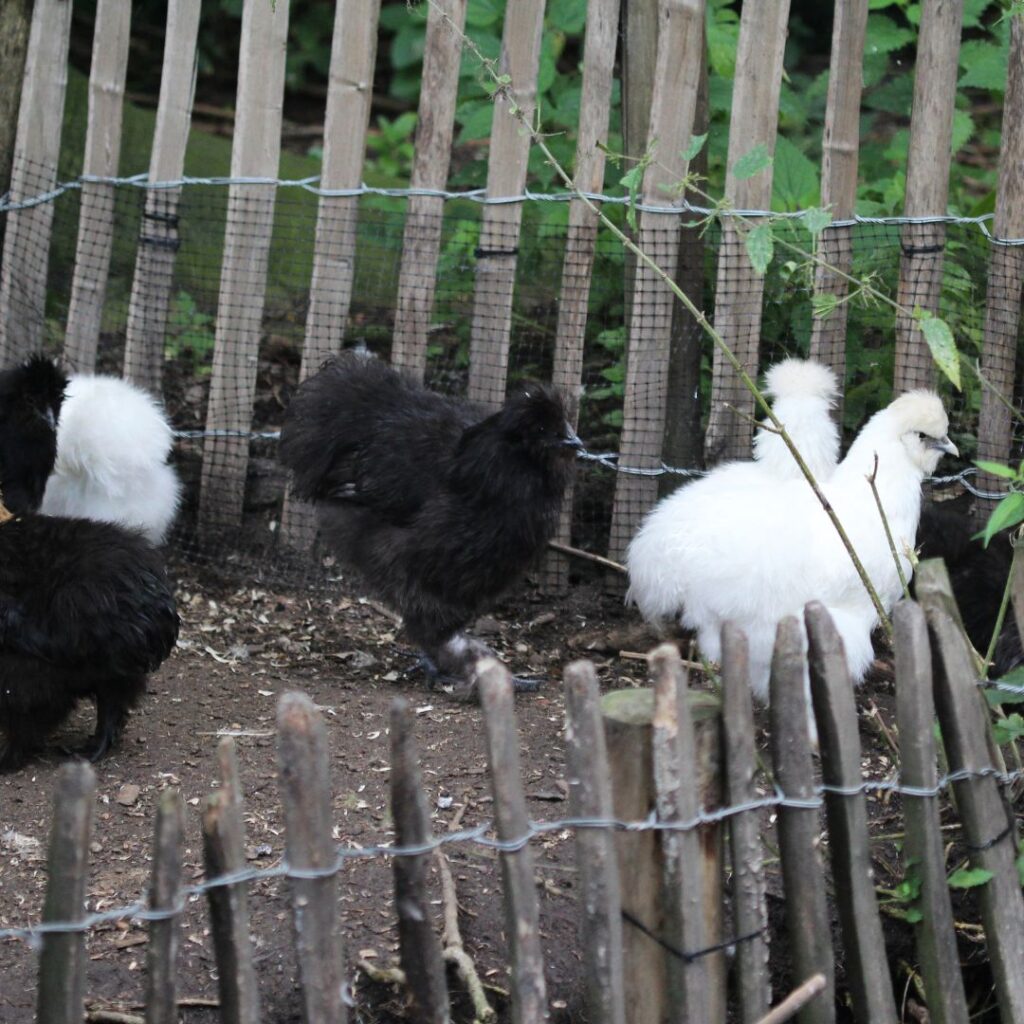
There are 18 varieties of the Silkie Bantam chicken recognized by the American Bantam Association(ABA)
- Black (Bearded)
- Black (Non-Bearded)
- Blue (Bearded)
- Blue (Non-Bearded)
- Buff (Bearded)
- Buff (Non-Bearded)
- Gray (Bearded)
- Gray (Non-Bearded)
- Paint (Bearded)
- Partridge (Bearded)
- Partridge (Non-Bearded)
- Self Blue (Bearded)
- Self Blue (Non-Bearded)
- Splash (Bearded)
- Splash (Non-Bearded)
- White (Bearded)
- White (Non-Bearded)
- White Naked Neck (Bearded)
Silkie Chicks
Silkie Chicken Breeds Personality and Behavior
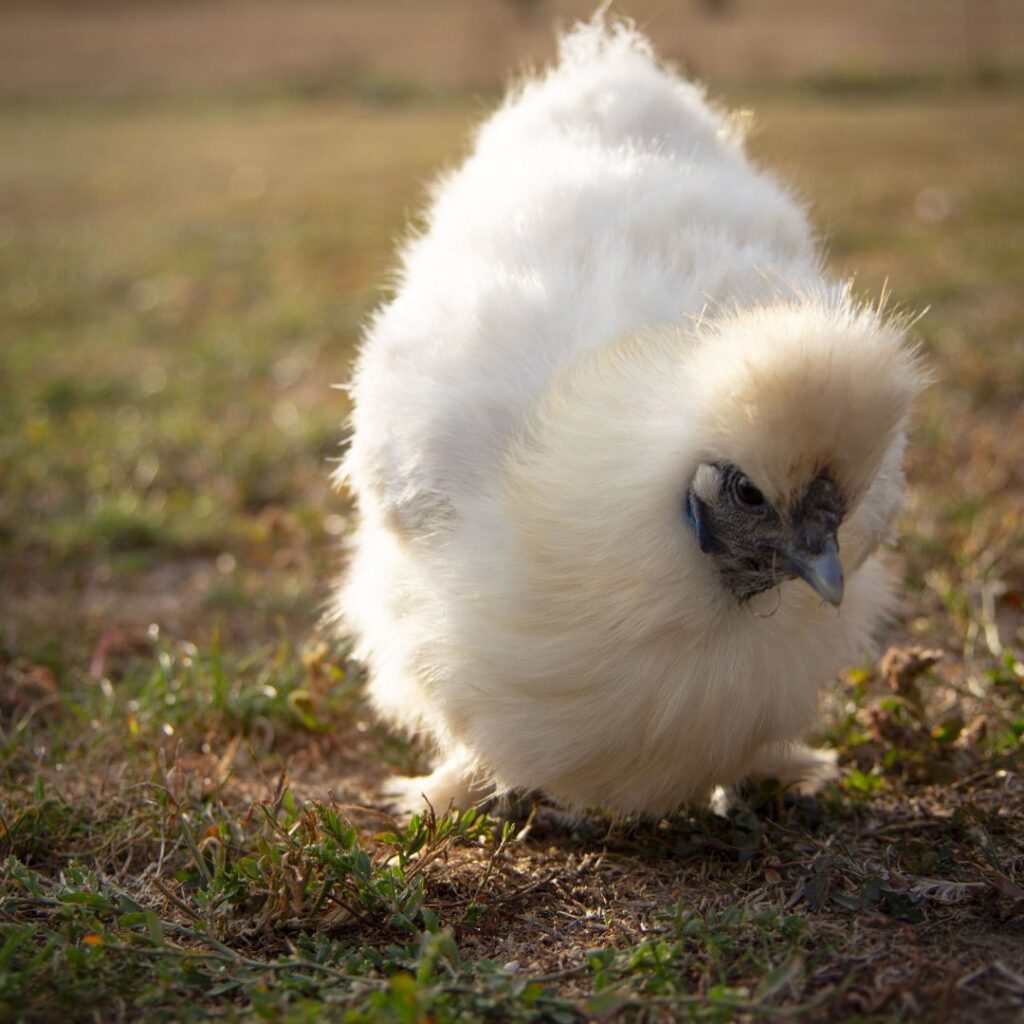
Silkies are known for their friendly, tranquil, and compliant personalities, making them ideal for families and backyard chicken keepers.
They are amiable and captivating, fond of interactions with humans, and children even find them simple to manage and embrace. Their gentle and calm nature makes them excellent companions for households with young kids and other docile breeds of chickens.
These are known to be lap chickens and even perch and visit upon their human’s shoulder.
However, it is important to note that Silkie’s docile nature can lead to flock issues when there are breeds of chicken with more assertive personalities in the same environment.
To avoid flock problems, it’s best to pair Silkies with other gentle and friendly breeds, ensuring a harmonious and peaceful flock.
Egg Production and Quality Of The Silkie Hen

what do silkie eggs look like? Are silkies good egg layers?
Silkie chickens are not known for their egg-laying capabilities, producing only about 100-120 eggs annually. Silkies lay eggs that are small, creamy-brown, nutritionally dense, and suitable for eating.
Silkie hens will start laying eggs at approximately 7-9 months of age, and their egg production declines after two-three years.
Silkie eggs are still cherished for their unique appearance and rich nutritional content despite their limited egg laying.
To ensure the best quality eggs, it’s essential to provide Silkies with a balanced diet, high-quality feed, and access to fresh water grit, as we will discuss further in the Housing and Coop Requirements section.
Are Silkie Hens Broody?
Silkie hens are known for being broody and tend to go broody regularly. Their strong maternal instincts for hatching eggs make them excellent mothers. Your silkie hen will diligently sit atop a clutch of eggs until hatching time arrives. It is often joked that Silkies can even hatch a rock due to their unwavering dedication to incubating and caring for their eggs.
Their broodiness and mothering skills make Silkie hens a valuable addition to a sustainable flock, especially if you want to hatch and raise chicks. Not only are they attentive mothers to their own offspring, but they are also known to care for the eggs and chicks of other chicken breeds, making them an indispensable asset in a multi-species flock.
Health and Care for Silkie Chickens

how to care for silkie chickens
Silkie chickens require attentive care to ensure their health and well-being. Due to their unique feather structure, they are particularly susceptible to mites and lice, making regular dust bathing and worming essential for their overall health.
Additionally, vaccination against Marek’s disease is recommended, as Silkies may be at risk of contracting this contagious affliction.
Grooming is also an essential part of caring for Silkie chickens, as the regular trimming of feathers around the eyes and rear end is essential for hygiene and breeding purposes.
Vaccinations and Preventative Measures
Vaccinating Silkie chickens against Marek’s disease is recommended to protect them from this highly contagious viral disease that can result in paralysis, blindness, and even death.
The Marek’s disease vaccine should be given to chicks on their hatching day. Some hatcheries will give vaccinations to their chicks or provide vaccinations upon request.
Taking the necessary precautions and providing vaccinations for your Silkies can significantly reduce the disease risk and ensure their health and happiness.
Grooming and Maintenance
Regular grooming and maintenance are essential for the health and well-being of Silkie chickens. This includes trimming their feathers with scissors or clippers, and being careful not to injure the bird.
Washing them with mild soap and providing clean dust bath areas are also essential aspects of their grooming routine.
In addition to regular grooming, your Silkie may require nail trimming a few times a year to maintain its overall health and comfort.
By providing consistent care and attention to your Silkie chicken, you can ensure their feathers remain clean and healthy and thrive in your flock.
Are Silkies Cold Hardy?
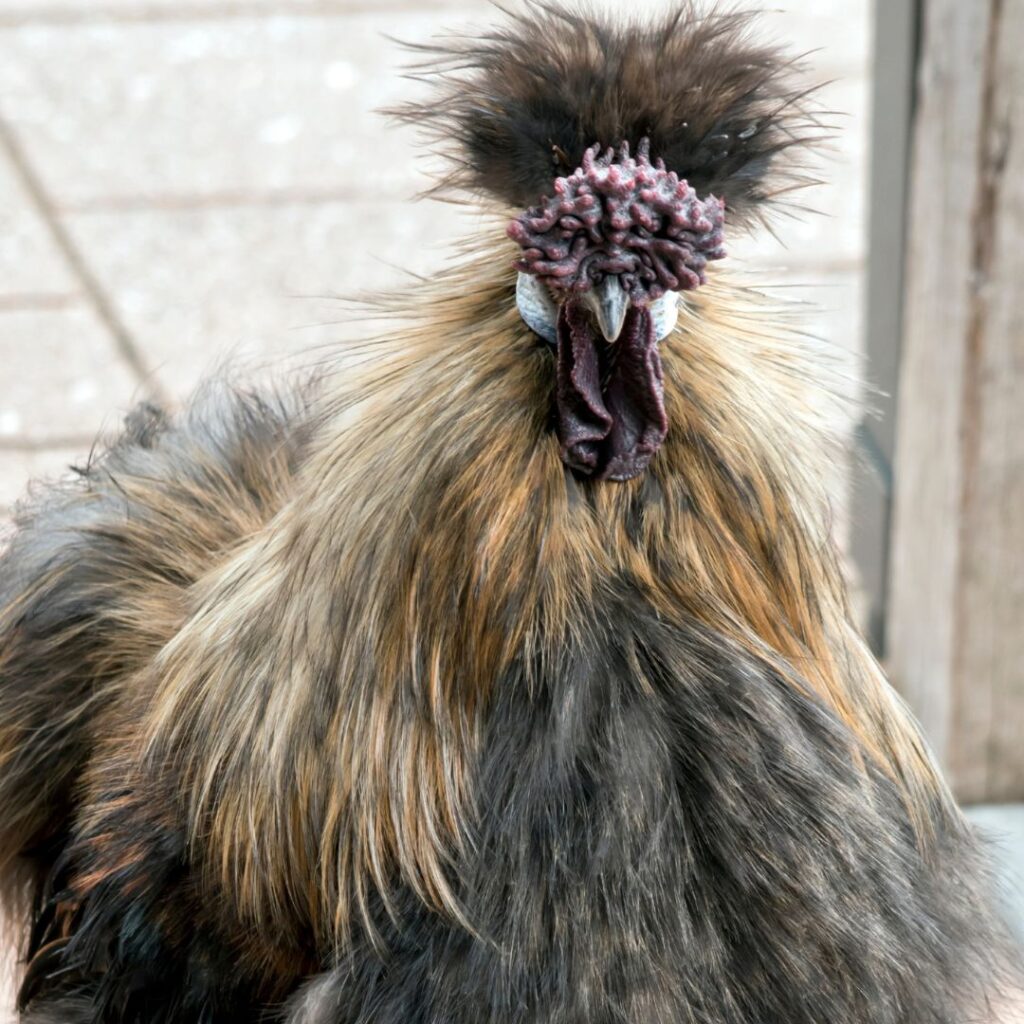
Silkie chickens are pretty cold-hardy and can tolerate temperatures close to zero degrees Fahrenheit with the protection of a shelter. Their fluffy feathers provide insulation against the cold, allowing them to withstand chilly weather better than some other chicken breeds.
However, providing adequate shelter during extreme cold is vital to ensure their health and safety.
Despite their cold hardiness, Silkie chickens have some challenges when it comes to wet and humid weather.
Their unique feather structure does not shield them from inclement weather, and the bird will likely become completely soaked in damp conditions. If your Silkie gets wet, it is essential to dry them off and keep them warm. Read more here about other cold hardy chicken breeds.
Read about Winter Chicken Care here.
Housing and Coop Requirements
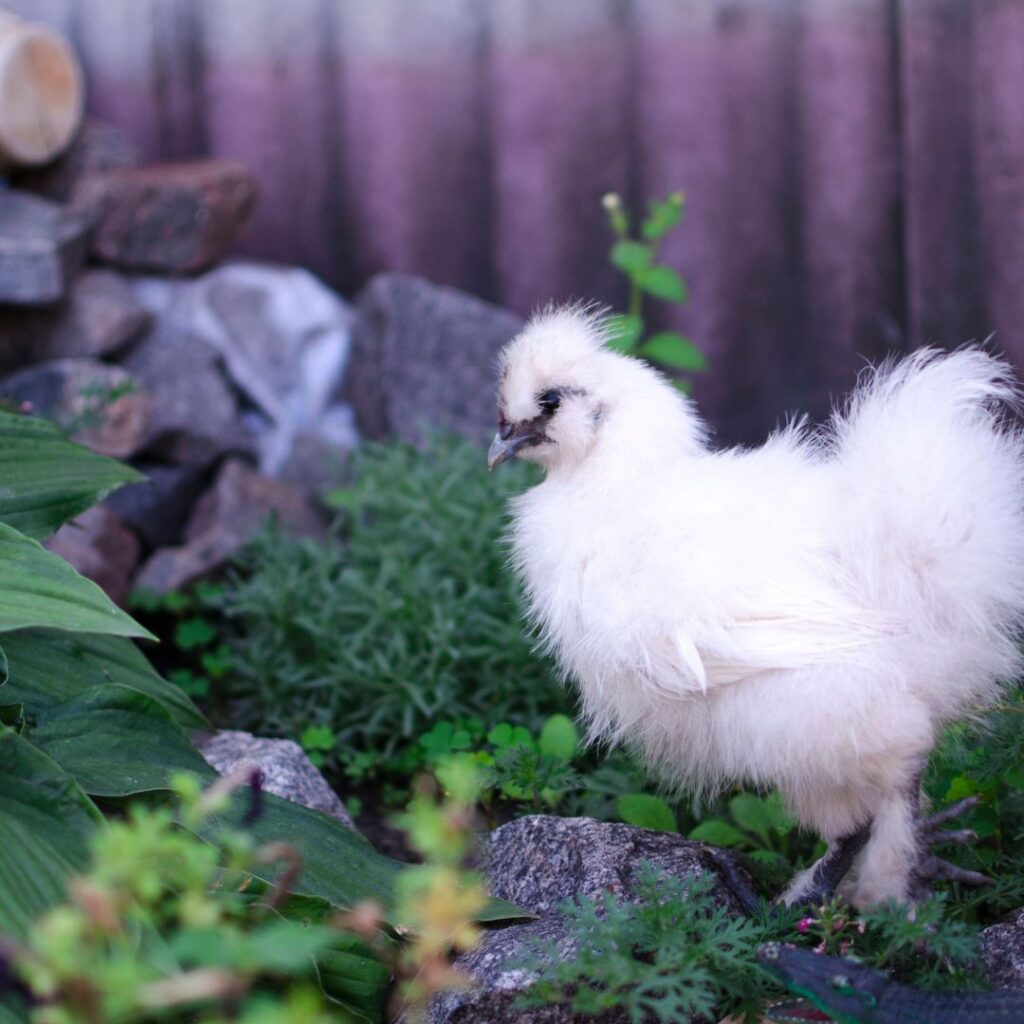
To ensure the happiness and well-being of your Silkie chickens, it’s essential to provide them with a suitable living environment. This includes high-quality feed and access to fresh water and oyster grit, which helps them produce strong and resilient eggshells.
Providing one nesting box for every three to four hens is also important to avoid squabbles and ensure a peaceful and harmonious flock. If you have multiple broody hens, you may want to add more nesting boxes, as the broody hens will occupy the area nonstop until chicks hatch and ready to leave the nesting boxes.
Silkie chickens tend to sleep on the floor in heaps rather than roost like other chicken breeds.
To protect them from predators at night, constructing a raised platform for them to sleep on can be beneficial. Old pallets can be economical to build; if you paint them with marine paint, they can be hosed off easily for cleaning.
4 square feet per Silkie is required within the coop, with at least 8 square feet of run space for standard-sized birds.
Is this Furry Chicken A Good Good Forager?
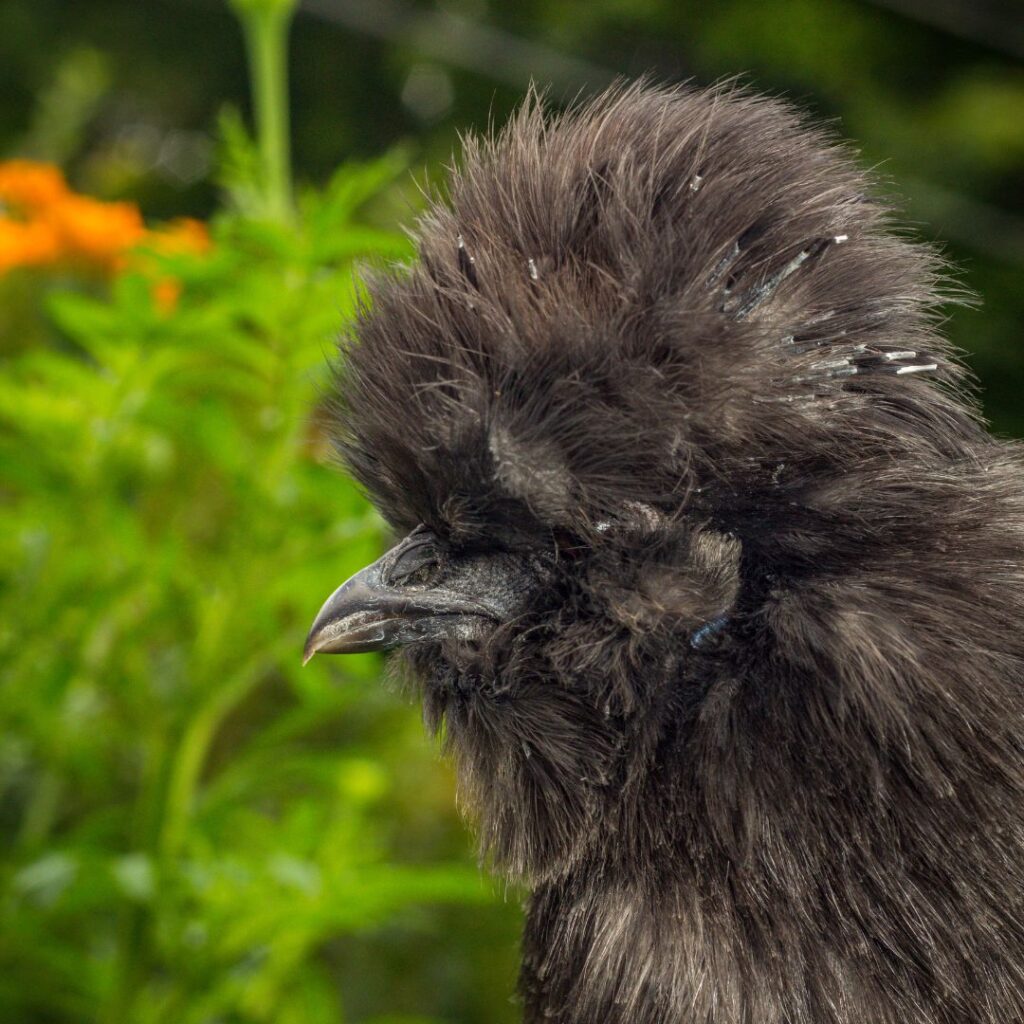
Silkie chickens possess a limited foraging ability, likely due to their limited vision caused by their head plumage. Although they may enjoy fresh air and outdoor exercise, they are not adept at capturing insects or seeking sustenance on their own. As a result, it is essential to supplement their diet with treats and fresh greens, ensuring they receive all the necessary nutrients for their health and well-being.
Providing your Silkie chickens with a balanced diet that includes commercial layer feed containing the necessary protein, calcium, and minerals for optimal health is essential.
In addition to their regular feed, offering them treats and fresh greens can help compensate for their limited foraging abilities and ensure they remain happy and healthy members of your flock.
Are The Silkie Breed Good For Urban Homesteads?
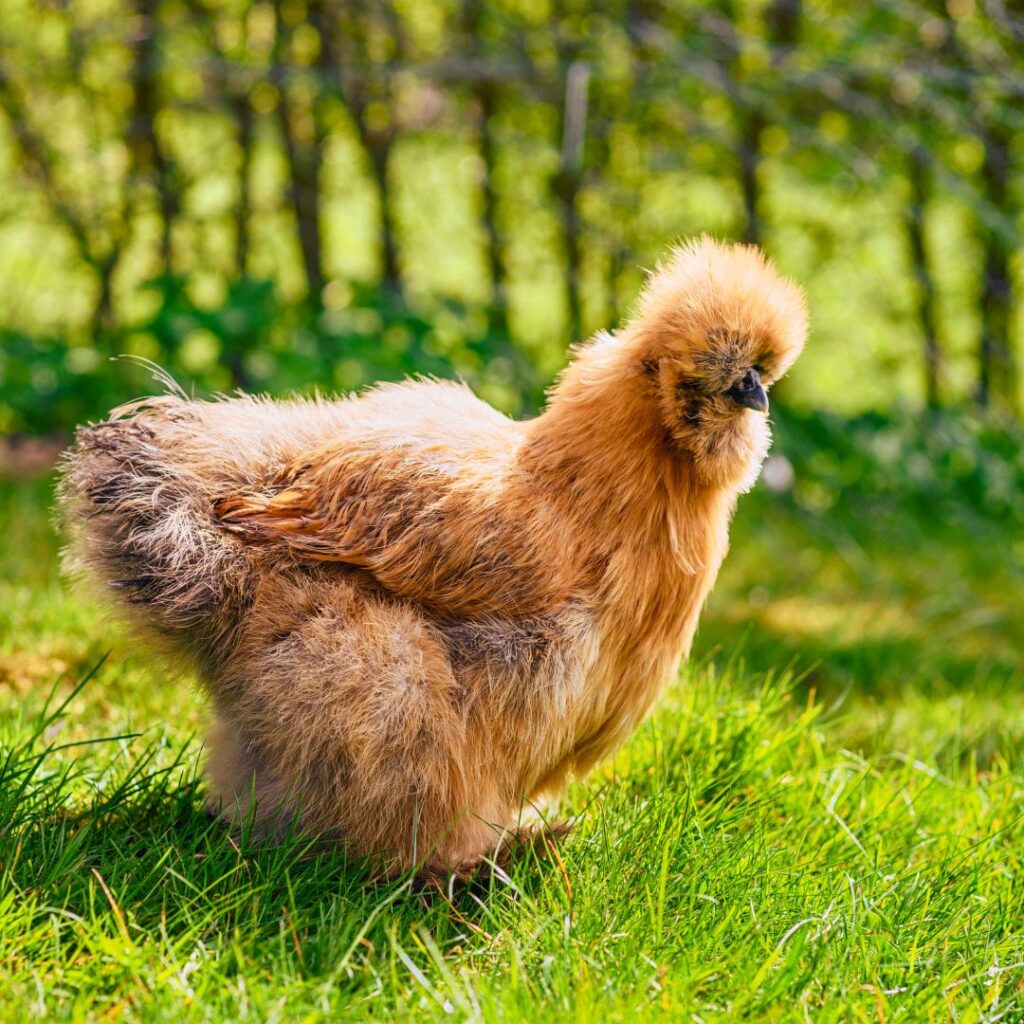
Silkie chickens make great house birds or pets for children due to their diminutive size, calm nature, and minimal space requirements. Their serene and amiable disposition makes them suitable companions for households with children and other docile breeds of chickens. Additionally, Silkie hens are renowned for their brooding capabilities and can even hatch and care for the eggs and chicks of other chickens.
However, there are some disadvantages to keeping Silkie chickens in urban environments. They may be subject to bullying by more aggressive flock members and may not be suitable for wet and muddy areas due to their feathering.
You’ll want to to weigh the pros and cons before deciding if Silkie chickens are the right choice for your urban homestead or backyard flock.
Raising Silkie Chickens: Tips and Considerations
Raising Silkie chickens requires a few considerations to ensure their health, happiness, and productivity. As mentioned earlier, Silkie hens begin laying eggs at approximately 7-9 months of age, and their egg production declines after two years. To maximize egg production and quality, selecting eggs from hens in their second season for incubation and hatching is recommended.
It is notoriously difficult to determine the gender of Silkie chickens until they reach approximately six months of age, making planning your flock challenging. Raising Silkies can be a rewarding and enjoyable experience despite these quirks, offering a unique and endearing addition to any flock or family.
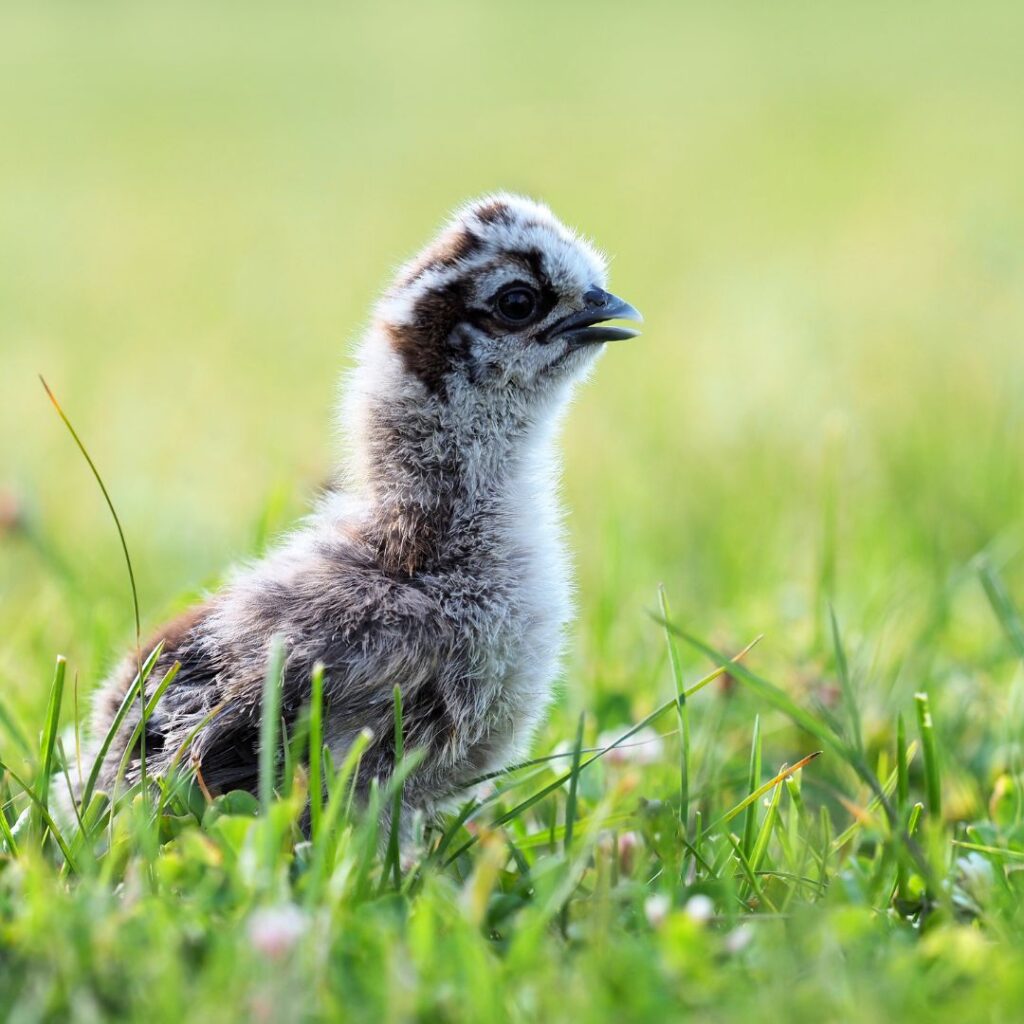
Summary
Silkie chickens are a unique and captivating breed with a rich history and distinctive features. Their friendly and docile personalities make them ideal pets and backyard companions, while their broodiness and mothering skills can be valuable assets to any flock.
Remember, providing them with proper care, including adequate housing, feed, grooming, vaccinations, and preventative measures against the disease is important.
Whether you’re an experienced poultry keeper, new at raising chickens, or a family looking for a charming new pet, Silkies can provide endless joy and fascination with their quirky furry feathers, teacup puppy appearance and gentle demeanor.
By understanding their unique characteristics and giving them the care and attention they deserve, Silkie chickens can thrive and become a treasured addition to your flock or family.
Frequently Asked Questions
Do Silkies lay blue eggs?
No, Silkie chickens do not lay blue or green eggs. Although they have blue ears, these unique birds typically lay a white, cream, or pink egg.
Can Silkies live with other chicken breeds?
Yes, Silkies are highly social and make great additions to any mixed flock. They get along well with other friendly breeds of chickens and adapt well to their environment.
Silkies can live peacefully among other chickens in a backyard coop!
Can you eat Silkie eggs?
Yes, it is possible to eat eggs from Silkie chickens. They are backyard chickens that lay white or cream-colored eggs that are safe to consume. Thus, it is generally considered safe to eat eggs from Silkies.
Are There Silkies that are Large fowl chickens?
Yes, there are standard-sized breeds of the Silkie. However, they are not Large fowl, weighing only around 3 – 4 pounds. The standardly sized breed silkies tend to be rarely found in the U.S chicken world.

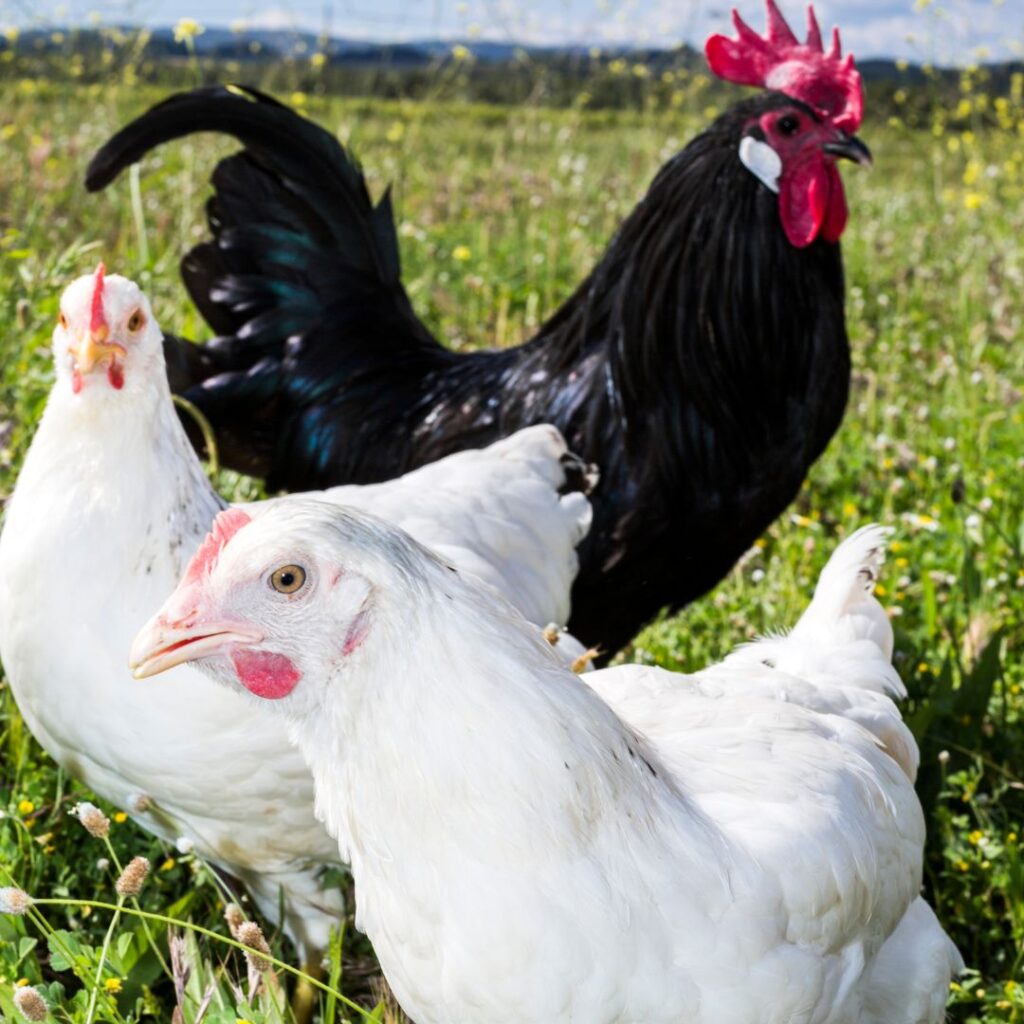
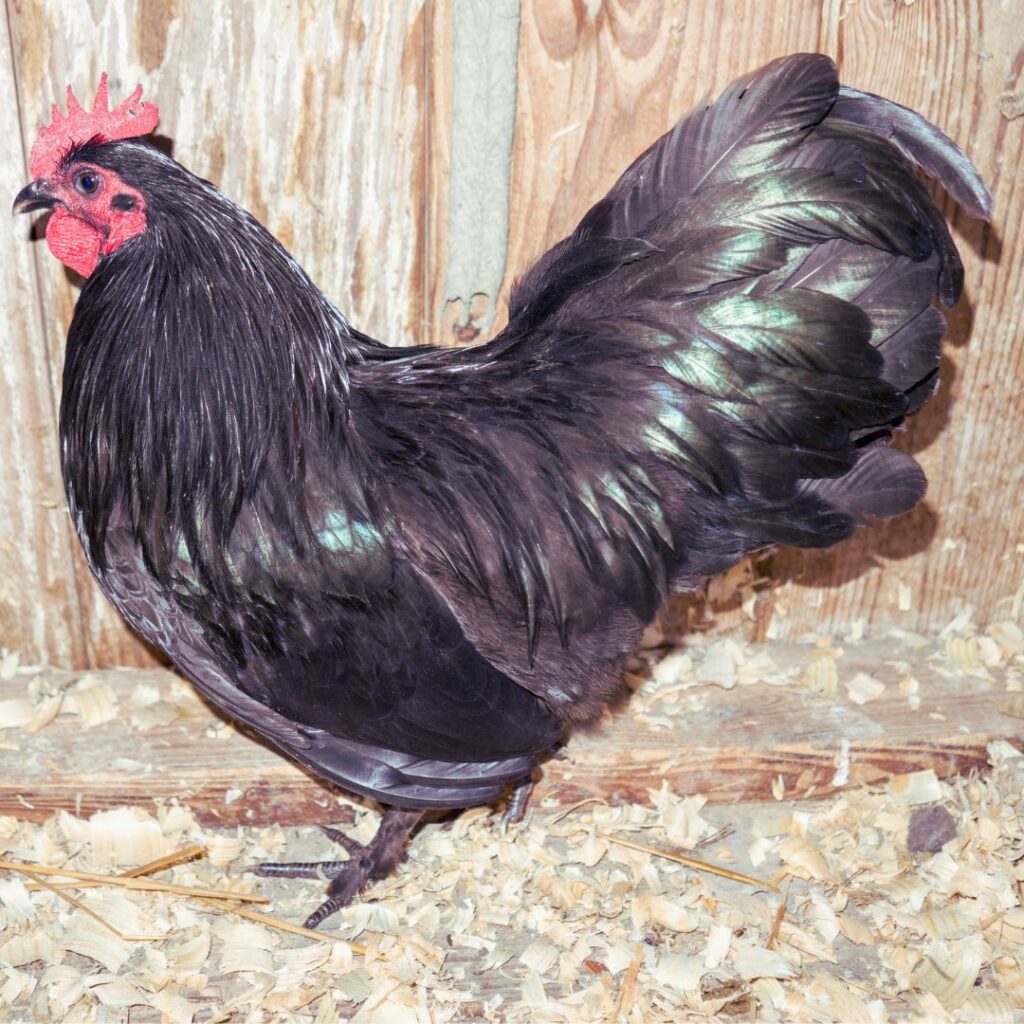

Pingback: 15+ Black Rooster Breeds And Hens - A Comprehensive Guide
Pingback: 11 Quirky Chicken Breeds & 11 Rare Chicken Breeds
Pingback: Rooster to Hen Ratio: Optimal Numbers for Healthy Flocks